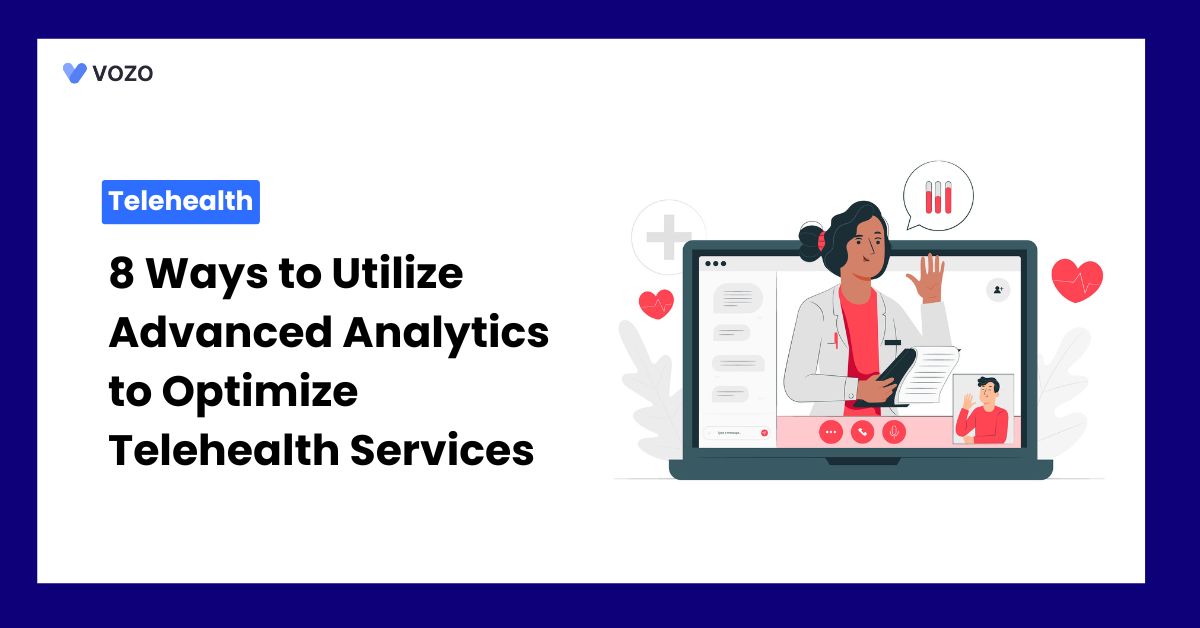8 Ways to Utilize Advanced Analytics to Optimize Telehealth Services
Telehealth is changing healthcare by making it easier and more convenient. Patients can now consult providers without visiting hospitals or clinics. However, some challenges remain in making virtual care more efficient. Many patients experience long wait times and poor communication systems.
This is where advanced data insights play a crucial role in optimizing telehealth. Using health data helps providers to track health conditions and detect problems. It also improves communication and reduces unnecessary delays in treatment. In this blog, we have shared the 8 ways to use advanced analytics to optimize telehealth services.
From better scheduling to stronger security, these improvements make healthcare safer, faster, and more effective for everyone.
The Growing Adoption of Telehealth Services
Telehealth is growing fast because of its ease of access and convenience. Many people prefer to receive virtual care instead of going to hospitals and clinics since the pandemic hit. Study shows that 63-fold increase in Medicare telehealth visits.
By 2025, the telehealth market is predicted to be worth more than $50 billion. With a large growth in the number of online provider consultations, there is a growing desire among patients for virtual visits.
However, some of the challenges in telehealth remain in keeping patients engaged from telehealth. Providers also face issues in managing time and security risks. To solve these issues, providers need to use better tools for improved telehealth services. These tools improve care quality while reducing delays and confusion.
How Advanced Analytics Can Enhance Telehealth
Data insights help healthcare teams work smarter and more efficiently. These systems analyze patient details to give useful medical suggestions to providers.
So, that providers can can deliver quicker and more effective care. This improves treatment quality and strengthens the patient experience. Some benefits include:
- Improved patient engagement through data-driven communication strategies.
- Early detection of health issues using predictive analytics.
- Optimized resource allocation for healthcare providers.
- Enhanced cybersecurity to protect patient data from fraud and cyber threats.
These tools also help reduce fraud and protect patient records. Now, let’s explore eight ways data insights improve telehealth.
8 Ways to Utilize Advanced Analytics to Optimize Telehealth Services
Advanced analytics can be used in 8 ways to optimize telehealth services.
1. Predicting Patient Needs Before Problems Occur
Healthcare professionals can use data to detect patient health issues early. This helps them act before symptoms become more severe later. These tools study patient records and identify possible health risks.
They also check lifestyle choices and their effect on health.
For example, hospitals can identify diabetes risks before issues start. Early guidance helps prevent complications before they become serious.
A U.S.-based hospital has used predictive analytics to identify high-risk patients and provided proactive follow-ups. The result: The hospital significantly reduced missed visits by sending early reminders. Patients received alerts, leading to a 30% drop in cancellations.
2. Tracking Health Data in Real Time
Remote patient monitoring devices track health information like oxygen levels and heart rate. This helps providers to monitor patients without in-person hospital visits. The collected data gets reviewed for any unusual activity patterns.
If warning signs appear, healthcare professionals can act immediately to help. Patients with heart conditions benefit from such tracking devices. A smartwatch can detect abnormal heartbeats and send instant alerts.
Study shows that monitoring patient vitals in real time helps to reduce hospital visits by 30%.
Related: How Integration of Remote Patient Monitoring and Telehealth Benefits
3. Making Appointment Scheduling More Efficient
Patients used to wait a long time for telehealth services which creates difficulties. Many patients face delays due to poor scheduling and mismanagement. Data-driven systems help balance appointments and avoid time conflicts.
These tools suggest better time slots by reviewing past schedules. This ensures patients receive medical attention at the right time. Efficient scheduling can help reduce stress and improve healthcare access.
4. Keeping Patients Engaged Through Personalized Communication
One of the biggest challenges is maintaining patient engagement. Many patients stop using telehealth due to a lack of connection or unclear treatment plans. Some forget follow-ups, while others lose interest over time. Healthcare providers can use data to improve patient engagement.
Systems track patient behaviors and send reminders when necessary.
Providers also provide personalized tips based on previous health records. This approach keeps patients involved and committed to their health.
5. Using Patient History to Improve Treatment Plans
Healthcare professionals make better choices when they understand a patient’s background. Past treatments, test results, and habits impact future treatment success. Data tools help providers to create customized treatment plans for patients.
For example, specialists adjust cancer treatment based on past responses. This reduces unnecessary procedures and improves the chances of full recovery. Patients receive care that fits their unique medical needs.
A study published in the Journal of Medical Internet Research shows that predictive analytics enhanced diagnostic accuracy in virtual consultations by 35%.
6. Understanding Patient Emotions Through Feedback Analysis
Online healthcare lacks the personal connection of face-to-face meetings. Some patients feel ignored or misunderstood during virtual appointments. Analyzing feedback helps identify common issues and complaints.
If many patients report long wait times, changes can be made. This improves service quality and makes telehealth more comfortable. Better communication builds trust and encourages continued engagement.
7. Protecting Patient Information from Cyber Threats
Online healthcare systems store important medical records for every patient. Cybersecurity risks make data protection a growing concern worldwide. Fraudsters can access personal health details and misuse them easily.
Tracking tools detect strange activity and prevent security problems quickly. This keeps medical records safe from hackers and cyber threats. Strong security builds trust in digital healthcare platforms.
8. Providing Support with Virtual Assistants
Many patients have common questions that do not need providers. This is where AI-powered chatbots step in. These bots assist with:
- Scheduling appointments
- Answering common medical queries
- Providing medication reminders
- Offering mental health support through conversational AI
These systems handle basic concerns, reducing pressure on medical staff.
Patients receive 24/7 support without long wait times or delays. This improves overall response times and keeps patients satisfied. Automated tools ensure smooth communication without major disruptions.
Related: 5 Ways Vozo Telehealth Makes Virtual Health Consultation Better
Vozo Telehealth Solution
Telehealth offers significant benefits for both providers and patients. Leveraging the Vozo Telehealth and EHR Integration can streamline your healthcare practice’s workflow.
With a vast range of features, such as scheduling appointments, audio/video/text consultation, analytics & reporting, better access to care, etc, healthcare providers and patients can:
- Reach out to patients remotely, ensuring more flexibility around appointment times.
- Saves patient travel time and makes it easier to fit appointments into busy schedules.
- Vozo Telehealth allows anonymity and ensures patients feel more comfortable opening up from the privacy of their home space rather than in-person therapist visits.
- This eliminates the transportation cost of getting to appointments.
- It also reduces overhead costs like rent and admin staff for therapists who can conduct remote sessions, and many insurance companies also cover teletherapy.
- Vozo Telehealth makes it easy to maintain regular appointments, especially for patients who travel frequently or move locations.
- Therapists and patients can connect through the telehealth platform from anywhere.
The Vozo Telehealth solution enables providers to reduce burdens and focus more on better patient outcomes remotely.
Reach out to Vozo and utilize cutting-edge telehealth solutions for better convenient quality healthcare.
About the author

With more than 4 years of experience in the dynamic healthcare technology landscape, Sid specializes in crafting compelling content on topics including EHR/EMR, patient portals, healthcare automation, remote patient monitoring, and health information exchange. His expertise lies in translating cutting-edge innovations and intricate topics into engaging narratives that resonate with diverse audiences.













